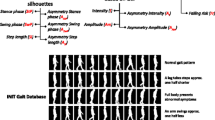Abstract
Every experiment should result in a protocol reflecting the main elements of the work performed, as well as the results obtained. The present review provides a brief overview of gait types, conditions affecting gait, methods for assessing gait parameters, and the results of applying these data to rehabilitation tasks. Gait parameters are recovered from processing video images of human movement in a known scene. The scene must be specially prepared in order to obtain reproducible results and must be independent of the conditions for capturing video. The parameters of a person’s gait must then be recorded in a file in a way supporting comparison, and this is very important for understanding the influences of rehabilitation conditions on a person’s motor activity. This article presents real results of studies of human movement during several passes through the same scene. The possibility of using this approach in the challenge of rehabilitation is demonstrated.


Similar content being viewed by others
References
Wang JW, Singh S (2003) Video analysis of human dynamics—a survey. Real-time Imaging J 9(5):320–345
Vitenzon AS, Petrushanskaya KA (2003) From natural to artificial control of locomotion. MBN, Moscow (in Russian)
Whittel M (2007) Gait analysis. An introduction. Force edition. Elsevier, Amsterdam
Skvortsov DV (2007) Diagnosis of motor pathologies using instrumental methods: gait analysis and stabilometry. TM Andreeva, Moscow (in Russian)
Kataev MY, Kataev SG (2011) A numerical method and algorithm for determining the center of gravity of a moving person from image stream analysis. Dokl Tusur 2((24) part 3):201–205
Kataeva NG, Kataev MY, Chistyakova VA, Khamaganov YA (2012) Automated assessment of the extent of walking impairment after stroke. Meditsinsk Tekhn (1):40–43
Kataev MY, Kataeva NG, Buintsev DN, Kurakov AB (2019) Identification of movement patterns based on the center of mass of a human figure using video images. Dokl Tusur 22(4):56–61
Erdmann WS, Kowalczyk R (2014) A personalized method for estimating centre of mass location of the whole body based on differentiation of tissues of a multi-divided trunk. J Biomech 48(1):65–72
Hof AL (2005) The condition for dynamic stability. J Biomech 38(1):1–8
Abros’kina MV, Protopenko SV, Ondar VS, Kaigorodtseva SA, Gasymly ÉD (2015) Correction of gait stereotype in patients with central hemiparesis syndrome activating rear foot strike. Vestn Vosstanov Med (1):14–18
Dvorkovich VP, Dvorkovich AV (2012) Digital video information systems (theory and practice). Tekhnosfera, Moscow (in Russian)
Vitenzon AS (1998) Patterns of normal and pathological human walking. Zerkalo‑M, Moscow (in Russian)
Bronnikov VA, Smychek VB, Mavlikaeva YA, Sklyannaya KA, Kravtsov YI, Gorbacheva AO, Vil’deman AV (2016) Characteristics of stabilometric and clinical indicators in patients with stroke sequelae during complex rehabilitation. Zh Nevrol Psikhiatr Im Ss Korsakova 116(8):65–70
Borzikov VV, Rukina NN, Vorob’eva OV, Kuznetsov AN, Belova AN (2015) Video analysis of human movements in clinical practice (review). Sovrem Tekhnologii Med 7(4):201–210
Toro B, Nester C (2009) A review of observation gait assessment in clinical practice. Physiother Theory Pract (19):137–149
Author information
Authors and Affiliations
Corresponding author
Additional information
Translated from Meditsinskaya Tekhnika, Vol. 58, No. 1, pp. 17–21, January-February, 2024.
Publisher’s Note
Springer Nature remains neutral with regard to jurisdictional claims in published maps and institutional affiliations.
Original article submitted July 17, 2023.
Rights and permissions
Springer Nature or its licensor (e.g. a society or other partner) holds exclusive rights to this article under a publishing agreement with the author(s) or other rightsholder(s); author self-archiving of the accepted manuscript version of this article is solely governed by the terms of such publishing agreement and applicable law.
About this article
Cite this article
Kataev, M.Y., Kataeva, N.G. & Kurakov, A.B. Protocol for results obtained by processing images of a moving person during rehabilitation tasks. Biomed Eng (2024). https://doi.org/10.1007/s10527-024-10359-2
Published:
DOI: https://doi.org/10.1007/s10527-024-10359-2




